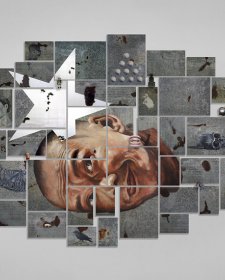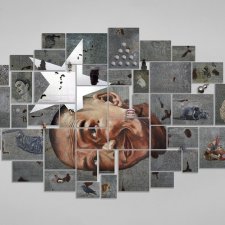Early in his career Esquillo was heavily influenced by ‘magic realist’ artists and Filipino social realists, but as his practice has developed he has broadened his themes to more politicised examinations of the contemporary and historical experiences of his nation. His technical prowess is evident in crafted realist paintings that often appropriate imagery from religious iconography, historical documentation and popular culture.
Esquillo’s recent work has imagined the journey of the Filipino nation, from serial colonisation and exploitation to a more hopeful future. His works examine individual, social, historical and communal identities, re-imagining familiar representations to question how these viewpoints are constructed. Esquillo continues to live and work in Manila, while exhibiting throughout the Philippines and internationally.
Materiel
The artist conjures likeness as a vehicle of passage, a process therefore of both an intimation of something still to come and of an imitation in which the self embodies a condition. This styling of the self lends well to the performance of a subjectivity, one that plays out as a material of history being staged again so that the self could act in and on its flux. It is a colonial history that is evoked by the jeep, brought to the Philippines as military hardware during the United States’ imperialist excursion in the Pacific in the first half of the twentieth century. In the course of time, it would be transformed by the local culture into the jeepney, which to this day persists as the country’s highly decorated popular transport, an index of postcolonial survival in dense cities and remote islands.
In Alab ng Puso (2010), the jeepney is retooled to reflect on the dynamic of the pasada, or the ‘past’ in Spanish and ‘route’ in Hispanized Filipino. It is, however, a particular kind of trip; it is about getting stuck or running in circles, in other words, of reiterating the basis of underdevelopment and systemic failure. Emblazoned on the front of the vehicle is the face of the artist. Above his image is a glowing heart, alluding to the Sacred Heart of Catholic iconography and a phrase in the national anthem that speaks of the ardour of patriotism. That this contraption is a means of transport is arguable. It has two sets of wheels. One is miniature; the other, which is quite spindly, is taken from a wheelchair that is grafted onto the jeepney. This ‘hybrid’ drags the wheelchair as the latter impedes the jeepney, resulting in a state of virtual paralysis because of the push-and-pull that takes it nowhere. When it was first exhibited, the artist marked the event with a performance, driving the work around the gallery and shouting out social commentary through a megaphone. Here, the image of the artist and the artist in the flesh come together to proffer a gesture, aboard a jeepney/wheelchair that is simultaneously about auto-mobility and stasis.
This is the second time that Esquillo has revised the jeepney as a materialisation of self in history. In 2001, he reconstructed a life-size jeepney in Fukuoka, Japan out of banig mat paintings, canvases that were stripped and then woven. He also performed with this piece, driving it and crashing it on a barricade of soda cans and a sack filled with bundles of blankets. He drives himself into this whorl of fabric and struggles to get out, a sign of being reborn, of crawling out of the womb. The jeepney as a trope is a contentious one, having been appropriated many times by artists and the state as an emblem of Filipino ingenuity. It has been exalted as an invention par excellence, a tribute to the ebullience of folk art and the resilience of the Filipino spirit that thrives amid adversity. It has likewise been cited by the avant-garde as a refunctioned materielof war, retrieved from its imperialist history and rechanneled to a potentially liberating ethos of community and native resistance. In other words, the jeepney is a form quite well hammered out, hewn by the bricolage of colonial technologies, and revived by the idiosyncratic, militant, ludic Filipino sensibility.
There is something devotional in how Esquillo performs the drama of identity, reflecting on the predicament of entitlement to a self as a kind of Passion in a folk Catholic register, an imitation of Christ; in the course of this identification with the suffering of the redeemer, the finite mortal becomes an intimate, a Christ-like personage. This lash binding imitation and intimation crafts the cross that is borne by the artist and his art. That he figures in some paintings as a ‘passionist’ partaking of the ‘passional’ experience testifies to the conflation of the self and other in a devotional contract in which the believer takes up the burden of salvation, which may be grasped as a transformative gesture that effects an ethical restoration in a world egregiously aggrieved.
The sequence from painting to installation to performance marks this effort. Alab ng puso takes off from the painting Third world 2004, which is then translated into a performative situation. The transition from the illusion of two dimensions to the phenomenological deed is a sign that the artist is, first, taking the risk to implicate his talent as a painter in realising social form in a world dismissed as ‘third’. It is an exceptional acumen that is keen on the accretion of resources like rubber and sawdust and the coincidences of images in the archives that transubstantiate into the morbid grotesqueries of history. Second, with the performance, he proposes his own body in the fulfilment of the promise of art’s commitment to do things right, or at least initiate a path toward it. All this is testimony to the polytropic nature of the artist and the jeepney and the contingent efforts of the emergent self to chart the many trails and thickets of what used to be merely the plateau of identity.
Patrick D. Flores
Professor of Art Studies and Curator
Vargas Museum of the University of the Philippines















